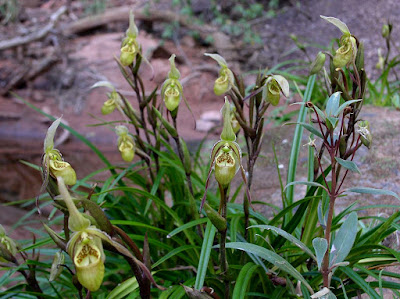Phragmipedium caricinum is endemic to the eastern flanks of the Andes in Bolivia; found in Caranavi, Alto Beni, Cochabamba, Cero del Ambro and Santa Cruz. It grows in tropical rainforests near waterfalls or on river boulders most often below the high-water mark, clinging to rocks along streams and wet limestone banks, sandstone rocks, or in red clay among mosses and grasses between 500 and 1500 meters above sea level.
Phragmipedium caricinum also called as The Reed Grass-Like Phragmipedium, Cypripedium caricinum, Cypripedium pearcei, Paphiopedilum caricinum, Phragmopedilum caricinum, Selenipedium caricinum, Selenipedium pearcei, is a species of the genus Phragmipedium. This species was described by Robert Allen Rolfe in 1896.
IDENTIFY PHRAGMIPEDIUM CARICINUM ORCHID PLANT
Phragmipedium caricinum is endemic to the eastern flanks of the Andes in Bolivia; found in Caranavi, Alto Beni, Cochabamba, Cero del Ambro and Santa Cruz. It grows in tropical rainforests near waterfalls or on river boulders most often below the high-water mark, clinging to rocks along streams and wet limestone banks, sandstone rocks, or in red clay among mosses and grasses between 500 and 1500 meters above sea level.
It is a medium sized, hot warm growing, fan-shaped terrestrial or lithophyte with no pseudobulbs and several, imbricate, conduplicate, leaf-bearing sheaths carrying several, linear, acuminate, glossy, dark green, conduplicate below into the base, 30-55 cm long, 0.5-1.5 cm wide leaves.
The Reed Grass-Like Phragmipedium blooms on a basal, 30 to 60 cm long, erect, purplish green, shortly pubescent, 3 to 7 flowered inflorescence with 1 to 3 elongate, sub-remote, tubular bracts and longer, spreading floral bracts that exceed the ovary in length and has successively single flowers occuring in the late winter through early fall. The flowers are yellow green with brownish-orange, rust-colored nerves, margins whitish.
PHRAGMIPEDIUM CARICINUM ORCHID PLANT CARE AND CULTURE
Cultural information should only be used as a guide, and should be to be adapted to suit you. Your physical location; where you grow your plants, how much time you have to devote to their care, and many other factors, will need to be taken into account. Only then can you decide on the cultural methods that best suit you and your plants.
Light:
Phragmipedium caricinum require medium to bright light (30000-70000 lux). It must be kept out of direct sunlight. It like more light in winter. It will grow in lower light but are much slower growing and will tend to climb more. Flower colour is also more intense when grown in bright light. Young seedling plants are reported to require less light.
Temperature:
It is an intermediate temperature plant with the optimum minimum temperature being about 10°C. The maximum temperature should ideally not exceed 30°C but higher temperatures up to 40°C will be tolerated for short periods if humidity is raised by misting or other techniques and good airflow is maintained with a fan if necessary. If daytime temperatures are above 35- 40°C the light level should be reduced further with additional shading or plants placed down low in the shade house.
Humidity:
The Reed Grass-Like Phragmipedium like high humidity preferably above 50%. Good air movement should be ensured. Growths that do not dry out by evening can get bacterial rot. Fans may be required to aid air movement if fungal or bacterial diseases are a problem.
Substrate, growing media and repotting:
Phragmipedium caricinum are best grown in deeper nursery shaped pots rather than squat pots. The potting mix contains a standard seedling grade 5-10mm bark mix containing perlite and sometimes coarse river sand and vermiculite.
It is recommend to repotting every year, to every year and a half. Keep the pot size as small as possible, just large enough to accommodate the roots. Trim any damaged or dead roots and let the potting mix fall away. If the plant is root bound, no further trimming is necessary, just pot into a slightly larger pot.
Watering:
These plants should be kept moist year round with frequent watering and not allowed to dry out. Plants can be kept a little drier in winter. Some growers stand the pots in shallow trays containing water about 2cm deep in warmer weather. In summer plants can be watered every 2 to 3 days in hot weather but in winter they may require watering only every 7-14 days depending on the potting mix and weather conditions.
Fertilizer:
It is recommended to applying a 20-20-20 or similar balanced fertilizer once every 2 to 3 weeks. Less fertilizer should be used in winter. Some growers suggest high phosphorus fertilizer in autumn encourages flower development but others actively discourage it.















COMMENTS